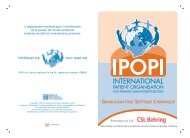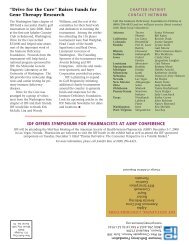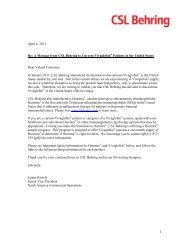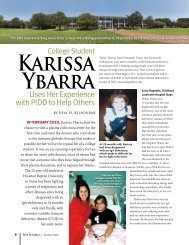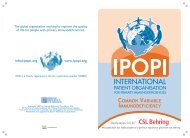IDF Patient & Family Handbook for Primary Immunodeficiency ... - IDFA
IDF Patient & Family Handbook for Primary Immunodeficiency ... - IDFA
IDF Patient & Family Handbook for Primary Immunodeficiency ... - IDFA
Create successful ePaper yourself
Turn your PDF publications into a flip-book with our unique Google optimized e-Paper software.
82<br />
Laboratory Tests<br />
Major Categories of Tests continued<br />
the functional capacity of T-cells. Most frequently<br />
this is done by measuring the ability of the T-cells<br />
to respond to different types of stimuli including<br />
mitogens (e.g. phytohemaglutinin [PHA]) and<br />
antigens (e.g. tetanus toxoid, candida antigen).<br />
The T-cell response to stimuli can be measured<br />
by observing whether the T-cells begin to divide<br />
and grow (called proliferation) and/or whether<br />
they produce various chemical mediators called<br />
cytokines (e.g. gamma interferon). There are<br />
an increasing variety of functional tests that are<br />
available to evaluate T-cell function, all aimed at<br />
providing data that allows quantitative assessment<br />
of T-cell functional status. However, it remains<br />
somewhat difficult to interpret the diagnostic<br />
significance of T-cell functional data that falls in<br />
between the extremes of markedly diminished and<br />
entirely normal function.<br />
Many of the primary cellular deficiencies are<br />
associated with genetic defects. This is particularly<br />
true with severe combined immune deficiency<br />
(SCID) where more than 10 different genetic causes<br />
<strong>for</strong> SCID have been identified. These can all be<br />
evaluated using current technology <strong>for</strong> mutation<br />
analysis and this approach provides the most<br />
accurate means to establish the definitive diagnosis.<br />
Evaluation of Neutrophil<br />
Immunity<br />
The laboratory evaluation of the neutrophil<br />
begins by obtaining a series of white blood cell<br />
counts (WBC) with differentials. The WBC and<br />
differentials will determine if there is a decline in<br />
the absolute neutrophil count (neutropenia). This<br />
is the most common abnormal laboratory finding<br />
with a clinical history that suggests defective<br />
neutrophil immunity. More than one WBC is<br />
necessary to rule out cyclic neutropenia.<br />
A careful review of the blood smear is<br />
important to rule out certain diseases that are<br />
associated with abnormalities in the structure<br />
of the neutrophil, or the way it looks under the<br />
microscope. An elevated IgE level may also<br />
suggest the diagnosis of Job’s (hyper IgE)<br />
syndrome. If these initial screening tests of<br />
neutrophil numbers are normal, testing would<br />
then focus on two possible primary immune<br />
disorders: chronic granulomatous disease (CGD)<br />
and leukocyte adhesion deficiency (LAD). Both of<br />
these disorders have normal or elevated numbers<br />
of neutrophils and each of these disorders has<br />
distinctive features that can help to direct the<br />
appropriate evaluation.<br />
Laboratory testing to diagnose CGD relies on<br />
the evaluation of a critical function of neutrophils<br />
that kills certain bacteria and fungi—the creation<br />
of reactive oxygen. This leads to a process<br />
called the oxidative burst that can be measured<br />
using a number of different methods including<br />
a simple dye reduction test called the Nitroblue<br />
Tetrazolium (NBT) test. In addition, a more recent<br />
testing approach uses flow cytometry to measure<br />
the oxidative burst of activated neutrophils<br />
that have been preloaded with a specific dye<br />
(dihyrorhodamine 123 or DHR) referred to as the<br />
DHR test. There is a third evaluation used by<br />
some laboratories called a chemiluminescence<br />
test. The DHR test has been used <strong>for</strong> more<br />
than ten years, and it is extremely sensitive in<br />
making the diagnosis. As a result of its excellent<br />
per<strong>for</strong>mance, this test has become the standard<br />
in most laboratories supporting clinics that see<br />
CGD patients regularly. The best confirmation<br />
of the specific type of CGD is suggested by the<br />
results of the DHR test, but requires confirmation<br />
by either specifically evaluating <strong>for</strong> protein<br />
involved or its related gene mutation underlying<br />
the disease.<br />
Laboratory testing <strong>for</strong> the most common <strong>for</strong>m<br />
of LAD Type 1 involves flow cytometry testing to<br />
determine the presence of a specific protein on<br />
the surface of neutrophils (and other leukocytes).<br />
This protein is part of a set of surface receptors<br />
that <strong>for</strong>m the Beta-2 integrins, proteins that<br />
are necessary <strong>for</strong> normal neutrophil motility<br />
or movement. When absent or significantly<br />
decreased, the movement of neutrophils to<br />
sites of infection is hampered and produces<br />
a large increase in the number of these cells in<br />
the circulation.<br />
Laboratory Evaluation of<br />
Complement<br />
The finest screening test <strong>for</strong> deficiencies in<br />
the complement system is the total hemolytic<br />
complement assay or CH50. In situations with a<br />
defect in one complement component, the CH50<br />
will be almost completely absent. Specialized<br />
complement laboratories can provide additional<br />
testing that will identify the specific complement<br />
component that is defective. There are some<br />
extremely rare conditions in which there are<br />
defects in another complement pathway. These<br />
can be screened <strong>for</strong> by using a functional test<br />
directed specifically at this pathway, the AP50 test.








